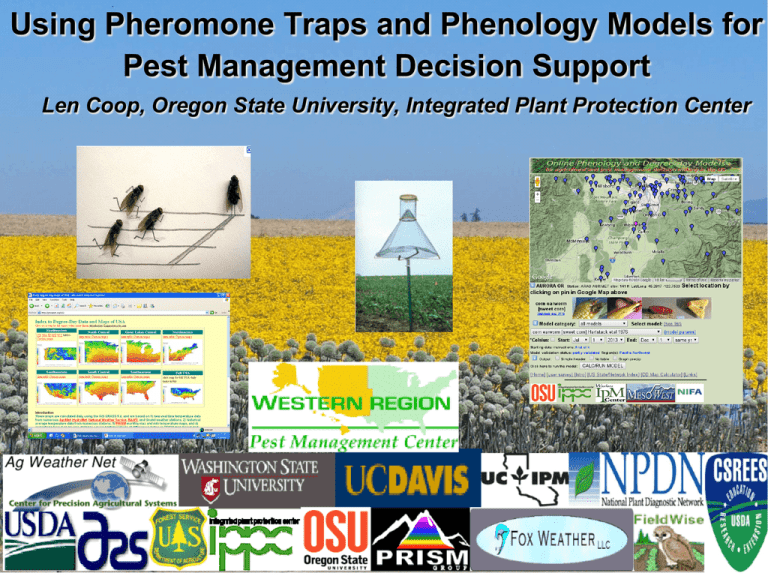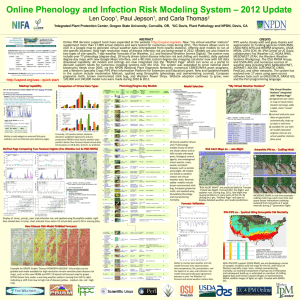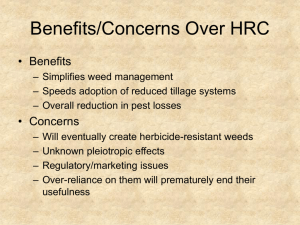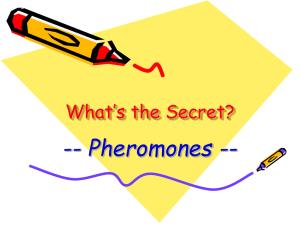
Using Pheromone Traps and Phenology Models for
Pest Management Decision Support
Len Coop, Oregon State University, Integrated Plant Protection Center
Topics for today's session:
!
Phenology and degree-day concepts
! Some features of the IPPC "Online weather data
and degree-days" website at uspest.org/wea
! Development and use of specific models – example
applications
! Pheromone trapping basics
! Some YouTube links on pheromone trap usage:
North Dakota Extension:
http://www.youtube.com/watch?v=mE5UUW2GFnI
Alabama Extension:
http://www.youtube.com/watch?v=Il6HkgKHXII
Typical pest management questions/tools:
"Who?" and "What?"
Identification keys, diagnostic guides,
management guides
! "When?"
Phenology models (crops, insects,
weeds), Risk models (plant diseases)
! "How Many and If?"
Pheromone traps,
economic thresholds, crop
loss models, sampling
calculators.
! "Where?"
GIS, precision
agriculture
!
Phenology and degree-day concepts
! Phenology: the study of periodic phenomena in their
relations to each other, e.g. how climate and weather
influence to plant development and growth.
! Heat unit concepts and examples first published by
Reaumur (1736), modern refs. in Arnold (1959, 1960)
! Degree-days: A popular method of recording
physiological time to represent development of many
plants and animals that do not self regulate temperature
! Degree-day models in common use for timing of
sampling and management events in agriculture; a
cornerstone of IPM
What to know about degree-days:
Insects have complex life cycles
Eggs
Larvae
Pupae (most)
Adults
-Timing of all stages
*is often*
predictable using
degree-days, which are
a two dimensional “heat
Unit“ of development
for cold blooded
organisms
Degree-day calculations – method varies:
Simplest: (daily max + min)/2 – low threshold
How fast are they going?
Single triangle compared with
typical daily fluctuation
Types of degree-days
Used for insects, plants, plant diseases, other uses
Simple
average: daily max + min/2 - lower threshold
(ignores any upper threshold)
Growing degree-days for corn: use simple avg but subst lower
threshold in place of min (if min is lower), subst upper threshold
in place of max (if max is higher)
Growing degree-days for cereals: same as simple average
Single and double triangle: simple geometric formulae (the
latter uses tonights min for second half of today)
Single and double sine curve: more complex trig. formulae
Actual degree-days: computed in real time ex. once/minute
Degree-hours: require hourly data
Fireblight degree-days: 4-day running degree-day total
Heating and Cooling degree-days: used by the power industry
Degree-day Models: A bit more detail
Developing degree-day models from lab studies
Temperature vs. development time
200
175
150
Days
125
Development time
(days)
100
75
50
25
0
35 40 45 50 55 60 65 70 75 80 85 90 95
Temperature (F)
Degree-day models: from lab studies
Temperature versus development
0.06
0.055
0.05
0.045
Rate (1/days)
0.04
0.035
0.03
Development
time (days)
0.025
Rate (1/days)
0.02
0.015
0.01
0.005
0
35 40 45 50 55 60 65 70 75 80 85 90 95
Temperature (F)
Degree-day models: x-intercept method (Arnold 1959)
Temperature versus development
0.06
0.055
0.05
0.045
Rate (1/days)
1/slope = 1/0.0011 = 920
~ DD requirement
0.04
0.035
0.03
Development
time (days)
0.025
Rate (1/days)
0.02
0.015
x-intercept ~ Tlow = 37 F
0.01
0.005
0
35 40 45 50 55 60 65 70 75 80 85 90 95
Temperature (F)
Degree-day Modeling Concepts
! Assume that developmental rate is linearly related to
temperature above a lower threshold (Tlow)
! Work best in temperate regions for populations that
have relatively few, non-overlapping generations
! Degree-day models: accumulate a daily "index of
development" (DD total) until some event is expected (e.
g. egg hatch)
! DD models often require a "biofix" - biological
monitoring event used to initialize the model
Weather and Degree-day Concepts
1) Degree-day models: accumulate a daily "heat unit
index" (DD total) until some event is expected (e. g. egg
hatch)
Eggs start developing: 0 DDs
cumulative:
daily:
20
20
38
18
70
32
84
14
106
22
Eggs hatch: 152 cumulative DDs
70o(avg)-50o(threshold)=20D
D
126
20
152
26
Degree-days: a tool for decision support, not
another tool we can store in the tool shed
http.uspest.org/wea
Expanding weather-driven pest models at OSU-IPPC
l
l
l
l
l
1996-7 – First IPPC online degree-day calculator, parameter database developed
for DD models, 45 weather stations in Oregon
1998-2000 – First PRISM/CAI DD maps developed, 1st online DD mapping
calculator, 288 weather stations in PNW
2003 – 900+ weather stations, 45 pest models; 5 state NW; begin PRISM/CAI
missing Tmax/Tmin data estimation
2007-8 – 10-12K+ weather stations, 2 additional grower networks, 60+ pest and
plant disease models, Fox Weather LLC/IPPC hourly weather forecasts
2013 – 16,000 weather stations, 100+ models, CROPTIME vegetable harvest
scheduling, Pest Event Maps
1997
2004
2008
2013
Increases in online access to Degree-Day models
Example system – Corn earworm in sweet corn
Females lay 1000 eggs each on average, singly on silks
Example system – Corn earworm in sweet corn Cornell Univers
USPEST.ORG - Corn
Earworm Phenology
Model – 1.
(as linked from
PNW Insect ManageMent Handbook)
USPEST.ORG - Corn Earworm Phenology model - 2.
Sex
USPEST.ORG
Pheromone -–Corn
chemical
Earworm
compounds
Phenology
released
modelby
- 3.
one
sex to attract an individual of the opposite sex.
What is Climate Mapping?
The process of interpolating climate statistics at irregularlyspaced station locations to a regular grid
“Geospatial Climatology”
The study of the spatial patterns of climate on the earth’s
surface and their causes
Products Guided by PRISM Climatologies
New USDA Plant Hardiness Zone Map
Near Real-Time Temperature and
Degree-Day Calculation
•
•
Uses CAI (PRISM temperature climatologies)
Current operational uses at IPPC:
l Daily DD accumulation maps
l Web-based dynamic DD maps with end-user settings
l Missing Tmax and Tmin data estimation
PRISM climate
Today’s differences
Today’s Map
Daily Online Degree-Day Maps: 48 contiguous states
Dynamic Online Degree-Day Maps: ex. corn GDDs May 8June 22
Degree-­‐day grids used by USDA APHIS PPQ to support CAPS survey programs; PEMs expected to enhance this support with more readily interpretable maps for numerous invasive species, such as the emerald ash borer. Pest Event Map example – Codling Moth – 1% Egg Hatch (WSU No Biofix Model)
Event = 395 DDs (Tlow=50, Thi=88)
Sex Pheromone – chemical compounds released by one
sex to attract an individual of the opposite sex.
Sex Pheromone – chemical compounds released by one
sex to attract an individual of the opposite sex. First
observed and described by JH Fabre, considered to be the
father of Entomology
Sex Pheromone – chemical compounds released by one
sex to attract an individual of the opposite sex.
Sex Pheromone – chemical compounds released by one
sex to attract an individual of the opposite sex.
Sex Pheromone – everyday use example:
Diamondback moth pan type pheromone trap
Uses of Pheromones in IPM – Misc.
East vs. West
Lure but no trap
100's of species have been studied
Several Types of Pheromone traps are available – these
Trece traps may all be usable (but not optimal) for a given
species.
Example system – Corn earworm in sweet corn www.trece.com
Different trap types
Have different ability
To attract and capture
The flying insect
Uses of Pheromones in IPM – lures and delta trap kit
Uses of Pheromones in IPM –
Handle lures properly – or you will become
one!
Uses of Pheromones in IPM – Mating Disruption
-Mating Disruption – the intent is to nearly saturate the landscape
with the artificial pheromone so that the males are unable to locate
any females that would be releasing natural pheromones
-This method has been a major breakthrough since the early 1990's
for several lepidoptera species such as codling moth, oriental fruit
moth
-A need for a large commercial market can limit investment by
profit-driven companies; some minor crops and key pests in
Oregon have likely suffered from this problem.
Initial research on mating disruption (Germany just before
WWII):
Uses of Pheromones in IPM – Mating Disruption
ex. Codling Moth
Uses of Pheromones in IPM – Mating Disruption
Uses of Pheromones in IPM – Mating Disruption
KG/HA per
year
Insecticide
Use
Uses of Pheromones in IPM – Areawide Monitor
KG/HA per
year
Insecticide
Use
Uses of Pheromones in IPM – Areawide Monitor
Uses of Pheromones in IPM – Milton Freewater
Areawide Monitoring
Uses of Pheromones in IPM – Attract and Kill
Attract and Kill (Attracticide): lure the insects using a pheromone
or other lure and use some type of insecticide to quickly kill them.
- Attracticide method has been successful against tephritid fruit
flies, cotton boll weevils and codling moths (Trematerra, 1997).
- Easily integrated with other control methods including biocontrol
- One area being researched for spotted wing Drosophila (not with
pheromones though).
Uses of Pheromones in IPM – Mass Trapping
Mass Trapping: attract and trap so many individuals of the local
population that the trapping itself controls the population. Best if the
field size is small and isolated, and the insect population is small and not
especially mobile.
- Sex pheromones have limited value since they only trap males, leaving
remaining males to mate with multiple females.
- Also readily integrated with other control methods.
-YouTube video (3.5 mins) on organic apple control including mass
trapping: http://www.youtube.com/watch?v=F_i_pnu3Lho
Mosquito oviposition pheromone lure – released by eggs to
attract more females to a suitable location - yet another
possible type and use for insect pheromones
Pheromones for anti-aggregation with Bark Beetles
www.herconenviron.com
“.. a significantly smaller proportion of trees was attacked in stands
treated with aerially applied verbenone-releasing flakes than in
control stands, with a threefold reduction in attack rate...”
“Hercon's DISRUPT MICRO-FLAKE Bark
Beetle Anti-Aggregate products ...”
Summary Points:
l
l
l
l
l
Phenology/degree-day models and pheromone trapping
are important tools in pest management; they work well
when used together with other IPM tactics (field
sampling, biocontrol, use of least-toxic chemicals when
a threshold population level is reached, etc.).
Phermone trap first or peak catch often used to
“BIOFIX” or start a degree-day model.
Pheromone uses include monitoring, mating disruption,
mass trapping, attract and kill, anti-aggregation, and
female oviposition.
Both tools are as yet under-exploited
IPPC website uspest.org/wea has evolved as a hybrid
for support of State, Regional, and National needs
Uses of degree-days and pheromones
in IPM – Questions?






